Vol. 11, No. 7 / Seafood Wholesaling in the United States and Gulf of Mexico Region
Abstract
In this issue, Dr. Posadas compiled and summarized the long-term economic contributions of the seafood wholesaling industry. The long-term trends in the number, wages, salaries, and earnings of workers and owners provide insights into the industry's contributions in providing jobs and income to its workforce. Comparing the socioeconomic characteristics of workers and owners in 2016 and 2020 discovers the workforce's changing profiles. The long-term data about the industry show its significance in the national Gulf regional economies.
Acknowledgement
This newsletter is a contribution of the Mississippi Agricultural and Forestry Experiment Station and the Mississippi State University Extension Service. This material is based upon work that is supported in part by the National Institute of Food and Agriculture, U.S. Department of Agriculture, Hatch project under accession number 081730 and NOAA (Office of Sea Grant, U.S. Dept. of Commerce, under Grant NA10OAR4170078, Mississippi Alabama Sea Grant Consortium).
Economic Contributions of Seafood Wholesaling
An economic contribution is defined as the gross changes in a region's existing economy that can be attributed to a given industry, event, or policy (Watson et al., 2007). It measures the gross change in economic activity associated with an industry, event, or policy in an existing regional economy.
This newsletter presents two types of economic contributions – employment or jobs and output or sales. The output or sales contributions are expressed in dollars for a specified year. Employment or jobs contributions are expressed in terms of a mix of both full-time and part-time jobs. During the past five years, the annual contributions of the industry averaged $8.4 billion in sales and more than 58,000 jobs (Fig. 1). However, these data are over three years old. No recent updates are currently available from NOAA Fisheries.
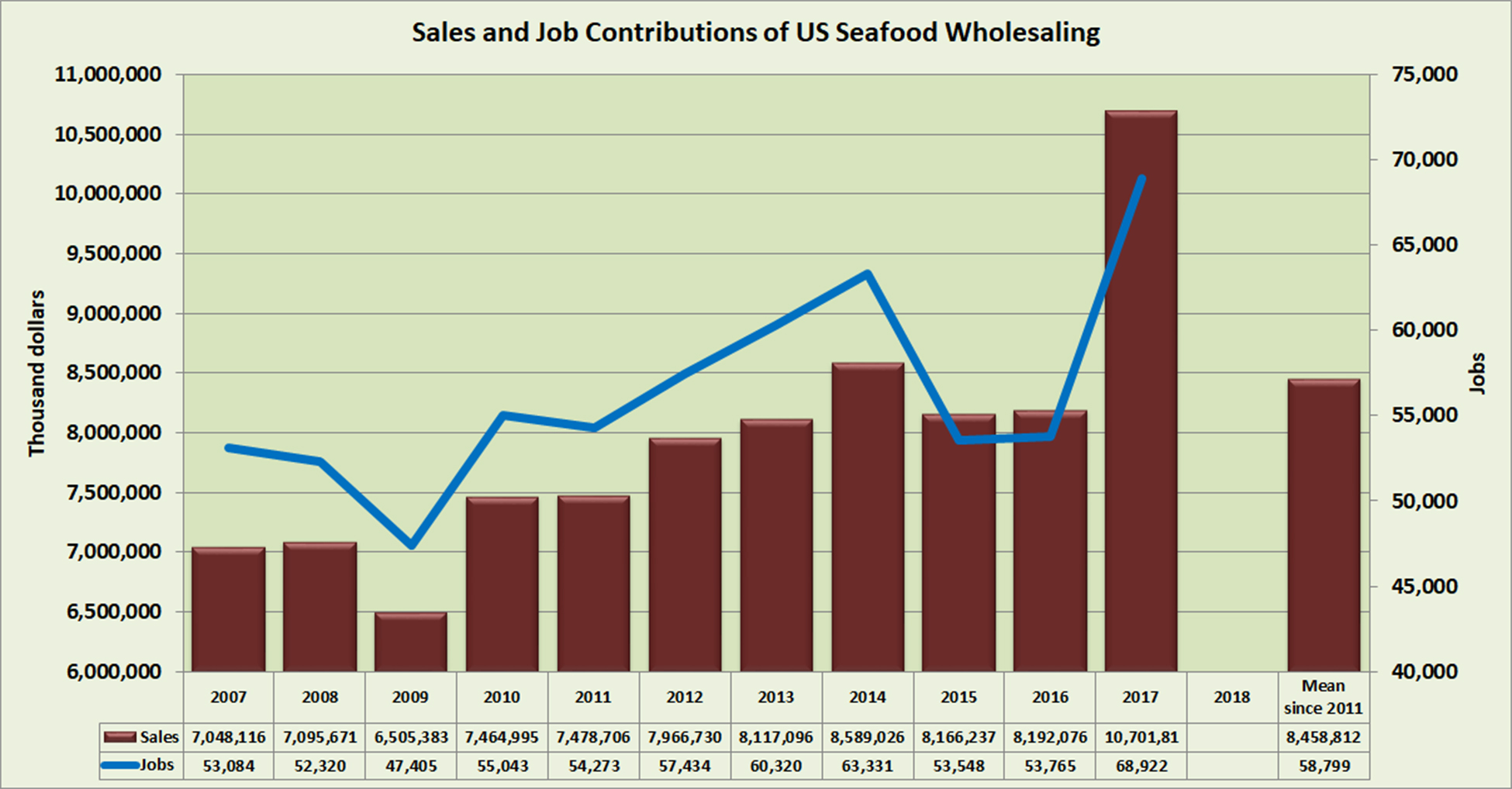
Total economic contributions consist of direct, indirect, and induced impacts. Direct effects result from the initial spending in the study region on salaries, supplies, raw materials, and operating expenses. Indirect contributions result from changes in the economic activity of other industrial sectors that supply goods or services to the sector being evaluated. Induced contributions are the result of personal consumption expenditures by industry employees.
U.S. Seafood Wholesalers' Gross Regional Product
The gross regional product (GRP), also called regional gross domestic product (GDP), is the market value of all goods and services produced within a given area over a specific period and is a good measure of the size, income, and productivity of a regional economy (EMSI, 2021). The GRP of the seafood wholesaling industry reached over $3.0 billion per year during recent years (Fig 2).
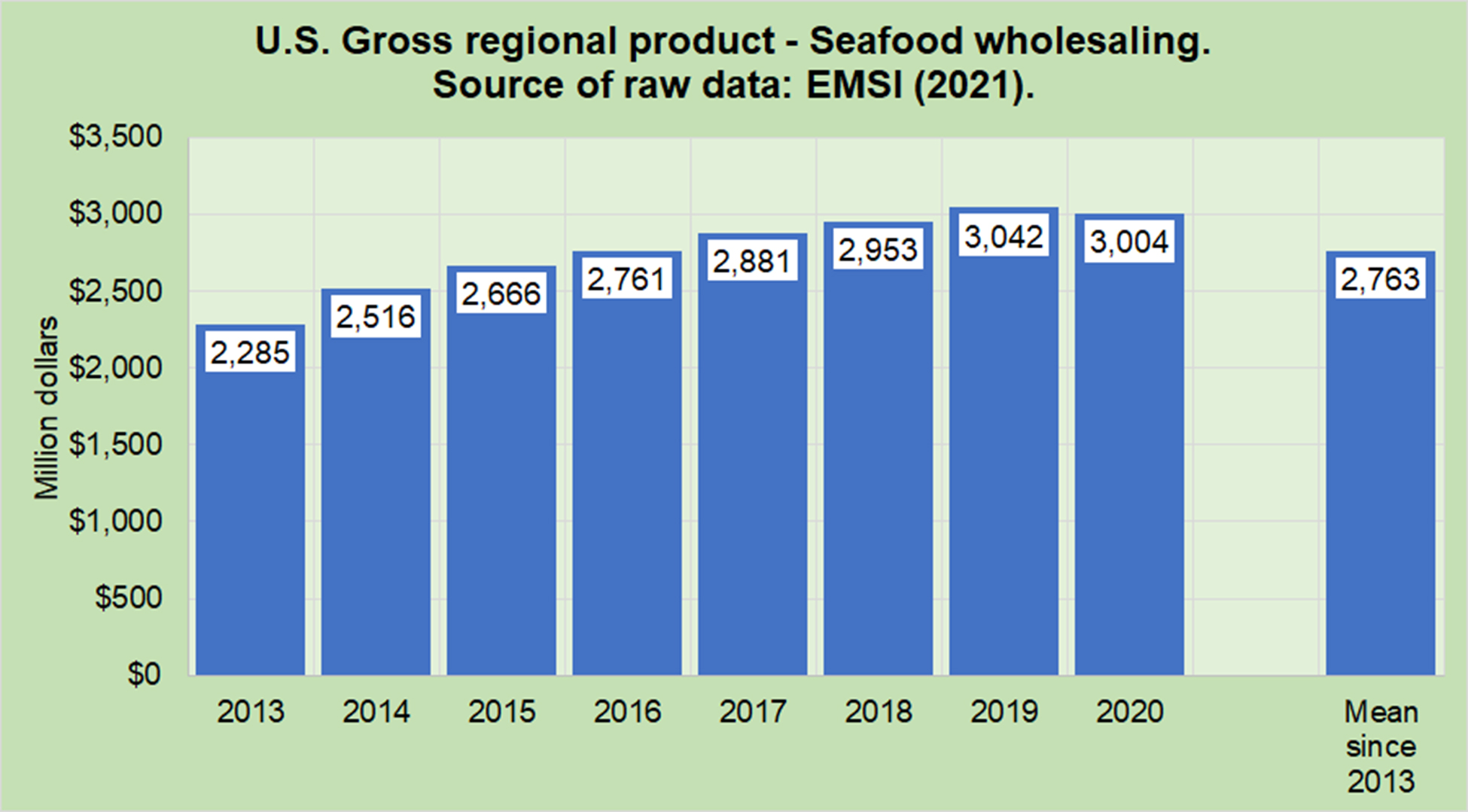
Seafood Wholesalers' Employment and Wages, Salaries, and Earnings
The fish and seafood merchant wholesalers (NAICS code 424460) industry comprises establishments primarily engaged in the merchant wholesale distribution of fish and seafood (except canned or packaged frozen) water (U.S. Bureau of Census. https://www.census.gov/naics/).
The industry directly provided about 28,000 jobs per year in the U.S. during the past decade (Fig. 3). The five Gulf of Mexico states (AL, FL, LA, MS, and TX) contributed about 20 percent of the jobs during the same period.
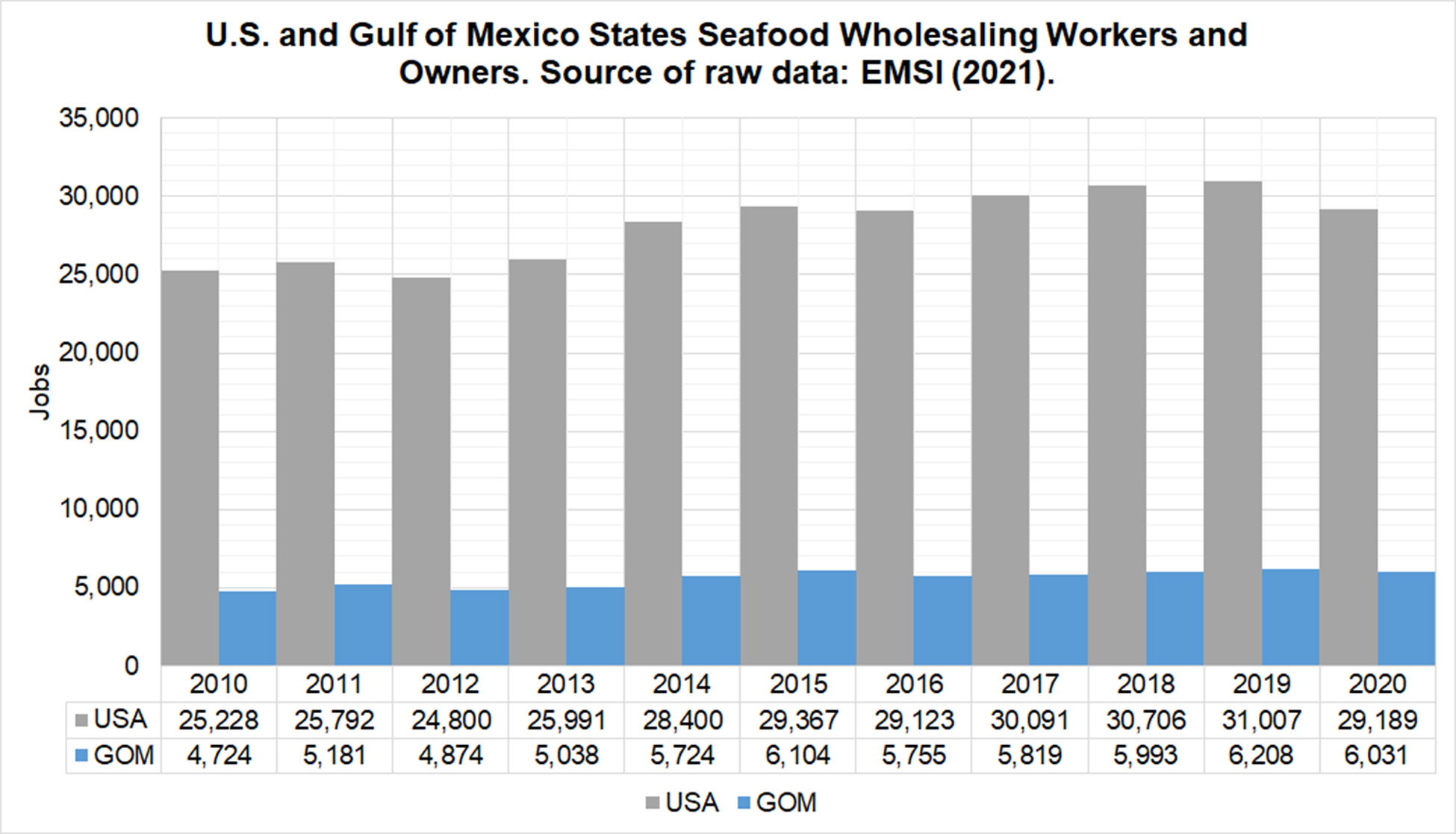
The combined wages, salaries, and proprietor earnings of all the QCEW employees, non-QCEW employees, self-employed, and extended proprietors averaged $49,000 per person in the past decade (Fig. 4).
The annual pay of workers and owners of these businesses in the five Gulf of Mexico States averaged almost $43,000 per person or 87 percent of the national average.
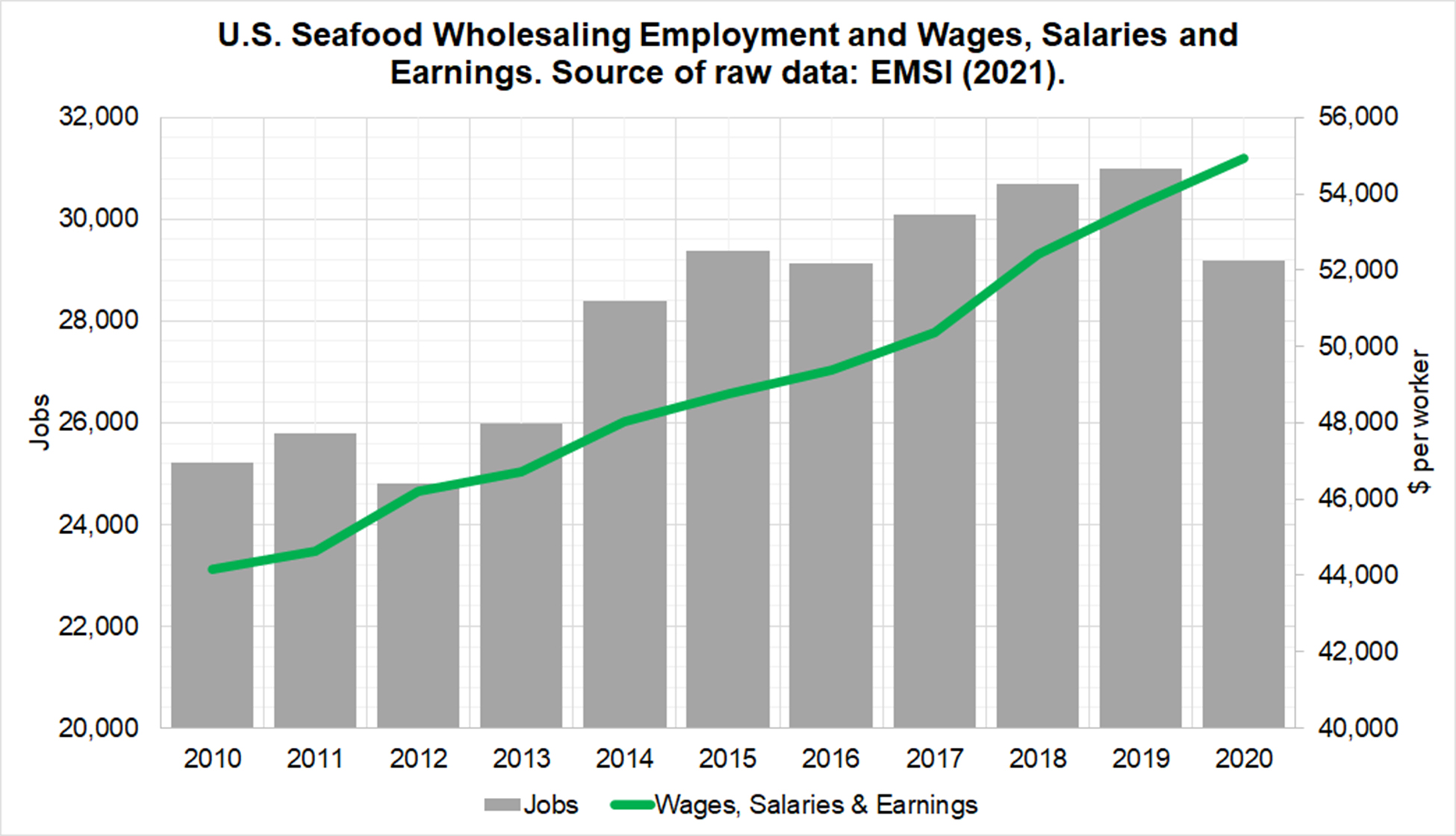
In summary, the economic indicators shown above indicated that the seafood wholesaler's industry in the entire U.S. and the Gulf of Mexico States was growing during the past decade.
However, the Covid-19 global pandemic undoubtedly caused a significant decline in sales, jobs, and incomes of workers and owners in 2020.
Distribution of Seafood Wholesalers' Employees and Owners by Gender
The 2020 industrial overview released by EMSI (April 2021) showed that approximately 72.8 percent were males (Table 1). About 27.2 percent of the workers and owners were females. In the Gulf States, 75.4 percent are males, while 24.6 percent are females.

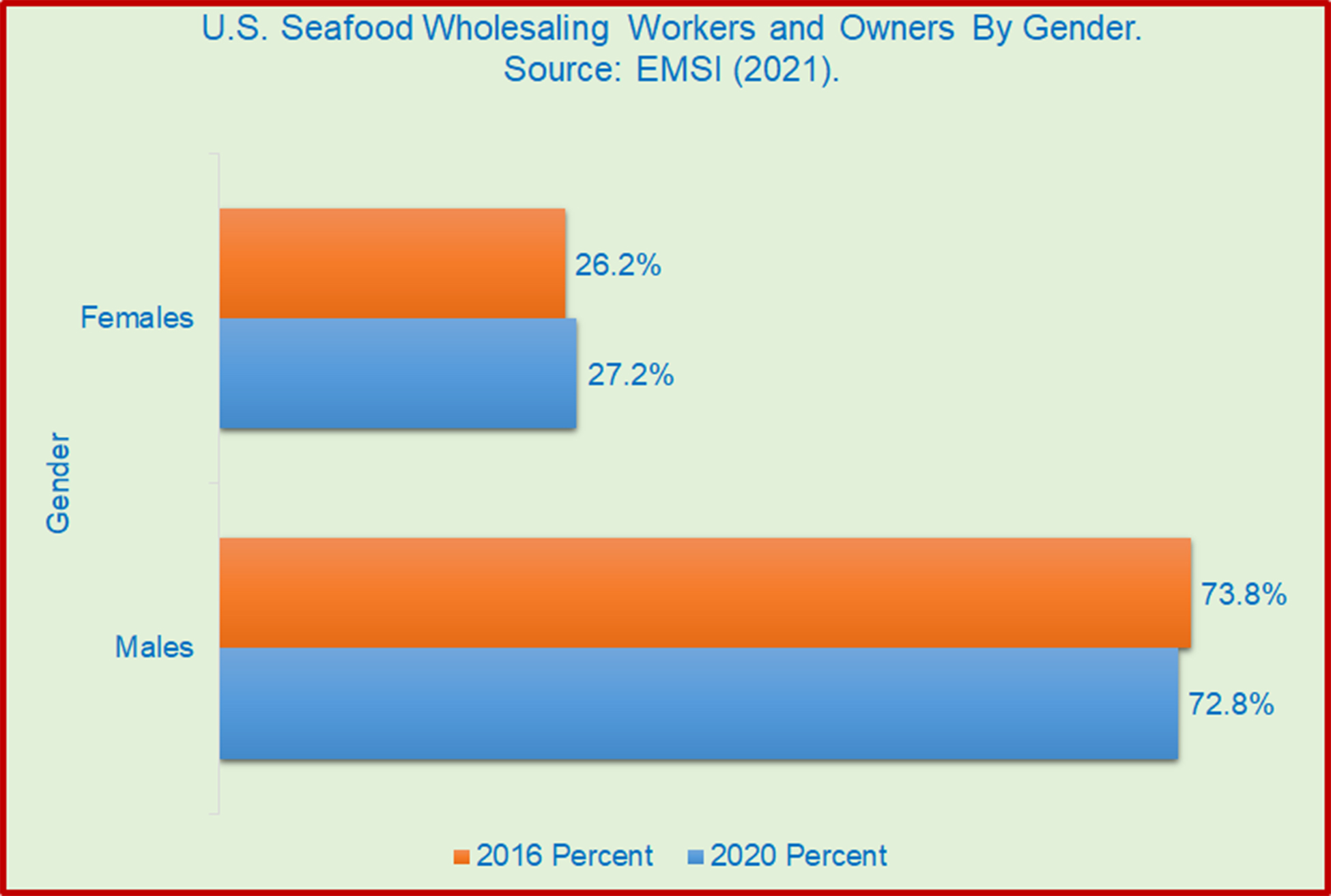
The proportion of male workers and owners of seafood wholesalers increased from 72.8 to 73.8 percent from 2016 to 2020 in the entire industry (Fig. 5). This upward trend resulted in relatively fewer women workers and owners engaged in the industry.
Distribution of Seafood Wholesalers' Employees and Owners by Race or Ethnicity
The 2020 industrial overview disseminated by EMSI (April 2021) also categorized the workers and owners by race or ethnicity (Table 2). The majority of the workers are White (51.6%), followed by Hispanic (25.9%), African American (11.9%), and Asian (8.6%). The rest are with two or more races, Native Hawaiian and American Indian.
In the Gulf States, relatively more Hispanic and African American workers and owners are involved in the industry. Fewer White and Asian workers and owners are engaged in the industry in the Gulf. States.
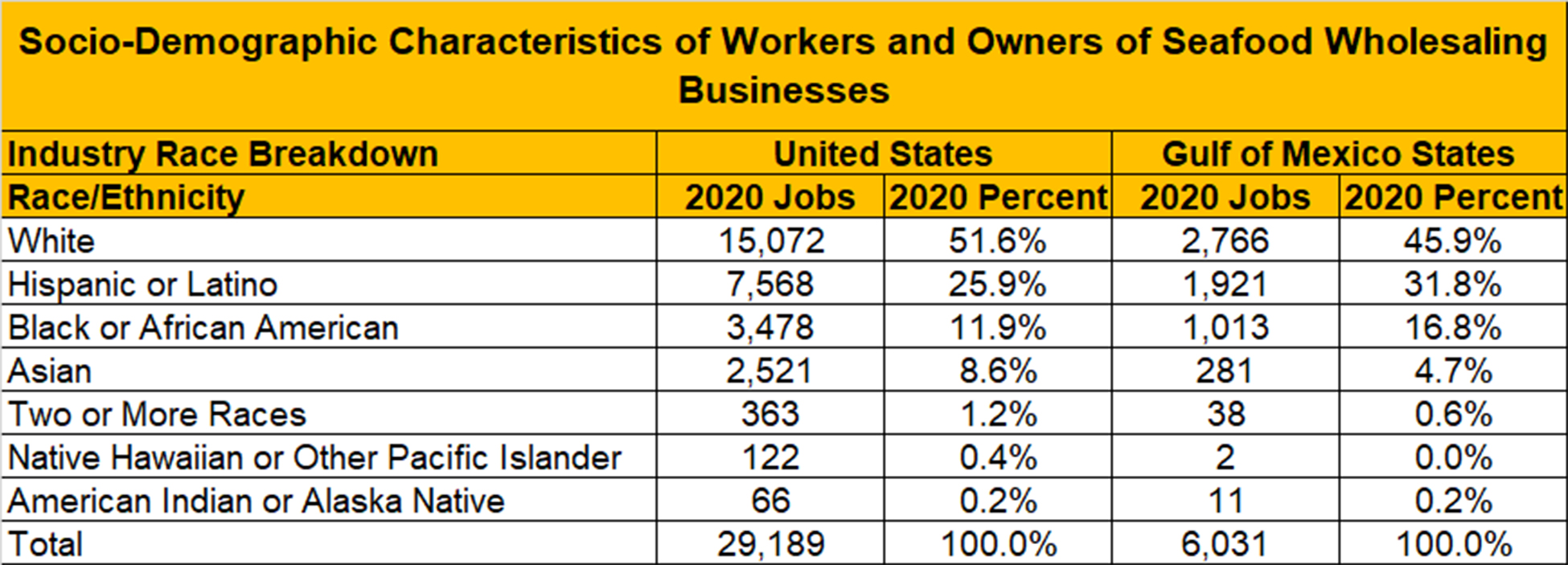
Relatively higher percentages of workers and owners were observed among Hispanic and African American workers and owners in 2020 (Fig. 6). Lower proportions were detected among White, Asian, and Native Hawaiian workers and owners in 2020.
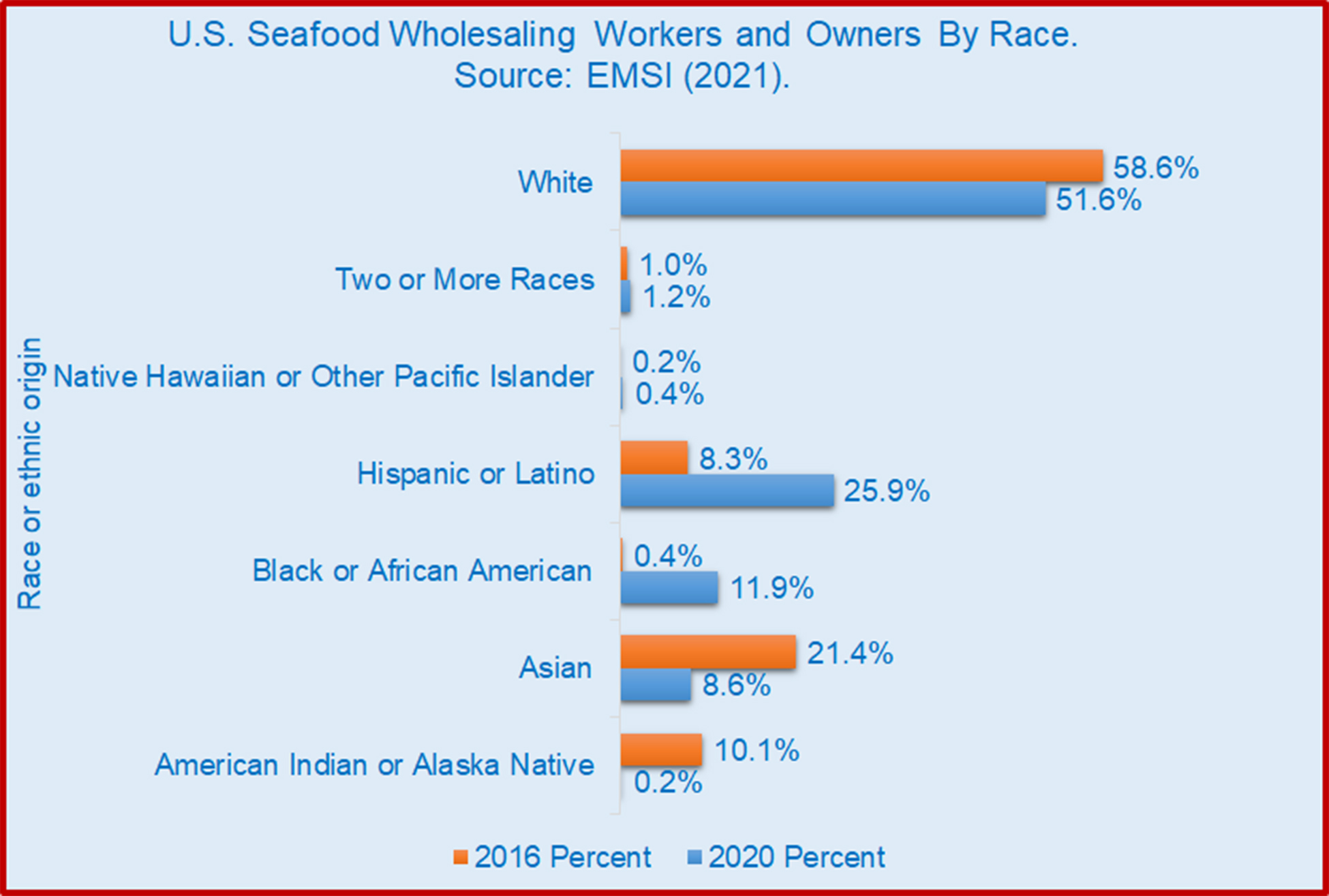
Distribution of Seafood Wholesalers' Employees and Owners by Age
The 2020 industrial overview published by EMSI (April 2021) also classified the workers and owners by age (Table 3). About 6.6 percent of the workers and owners are 65 years old and above. One out of five workers and owners were 55-64 years old. The 45-54 years old group added 25.0 percent of the total. The 35-44 years old consisted of 22.4 percent of all workers and owners. The younger employees and owners comprised the rest of the workforce.
Workers and owners in the Gulf States are relatively older than the national average. Gulf workers and owners averaged 45.0 years old compared to 44.7 years old among all U.S. workers and owners.
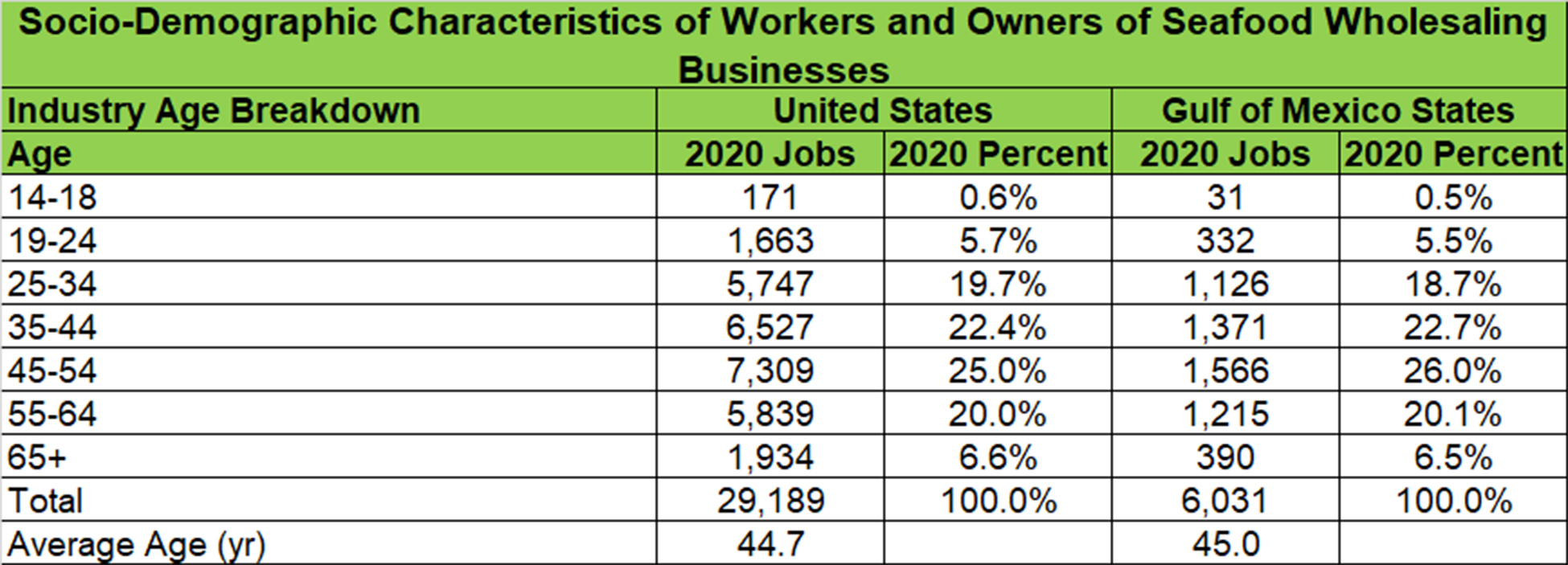
There were relatively more older workers and owners (55 years old and above) in 2020 compared to 2016. Moderately, more 25-34 and 35-44-year-old workers and owners were observed in 2020. However, there was a decline among 45-54, 19, and younger workers and owners in 2020. On average, U.S. workers and owners were relatively older in 2020 (44.7 years old) compared to 2016 (44.4 years old).
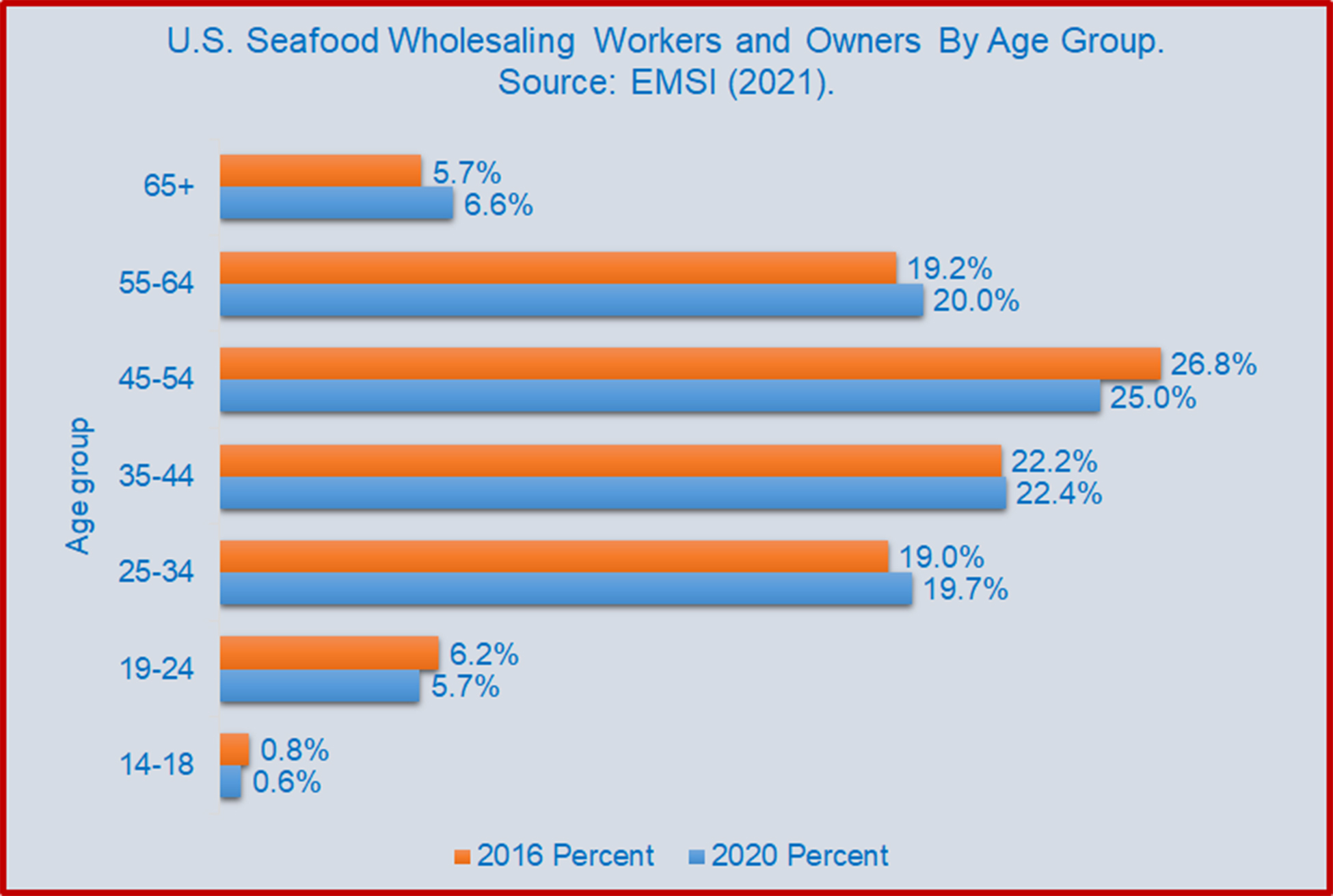
My Seafood Wholesalers' Economics Outreach
Posadas, B.C. Seafood wholesalers in the United States and Gulf of Mexico Region. Mississippi MarketMaker Newsletter, Vol. 11, No. 7. July 14, 2021. http://extension.msstate.edu/newsletters/mississippi-marketmaker.
Posadas, B.C. 2021. 2021 Seafood Wholesaling Jobs, Incomes, and Profiles. https://youtu.be/5bFMCf738Uk.
Posadas, B.C. Landings and Dockside and Wholesale Prices of White Shrimp in the United States. Mississippi MarketMaker Newsletter, Vol. 10, No. 6. June 9, 2020. http://extension.msstate.edu/newsletters/mississippi-marketmaker.
Posadas, B.C. Landings and Dockside and Wholesale Prices of White Shrimp in the United States. Mississippi MarketMaker Newsletter, Vol. 10, No. 6. June 9, 2020. http://extension.msstate.edu/newsletters/mississippi-marketmaker.
Posadas, Benedict C. Dockside and Wholesale Prices of Brown Shrimp in the United States. Mississippi MarketMaker Newsletter, Vol. 10, No. 5. May 28, 2020. http://extension.msstate.edu/newsletters/mississippi-marketmaker.
Posadas, Benedict C. Commercial blue crab landings, dockside values, and wholesale prices. Mississippi MarketMaker Newsletter, Vol. 10, No. 4. April 30, 2020. http://extension.msstate.edu/newsletters/mississippi-marke.tmaker.
Posadas, Benedict C. Economic Contribution of Fish and Seafood Merchant Wholesalers in Mississippi Gulf Coast. Mississippi MarketMaker Newsletter, Vol. 9, No. 12. December 3, 2019. http://extension.msstate.edu/newsletters/mississippi-marketmaker.
Posadas, B.C., A.E. Jefferson, and B.K.A. Posadas, Jr. 2018. Employment, Incomes, and Characteristics of Workers and Owners of Fresh Fruit and Vegetable Merchant Wholesalers in the Gulf of Mexico and the United States. Mississippi MarketMaker Newsletter, Vol. 8, No. 3, February 23, 2018. https://extension.msstate.edu/newsletters/mississippi-marketmaker/2018/vol-8-no-4-fruit-and-vegetable-merchant-wholesalers.
Suggested Citation
Posadas, B.C. Seafood wholesalers in the United States and Gulf of Mexico Region. Mississippi MarketMaker Newsletter, Vol. 11, No. 7. July 14, 2021. http://extension.msstate.edu/newsletters/mississippi-marketmaker.









